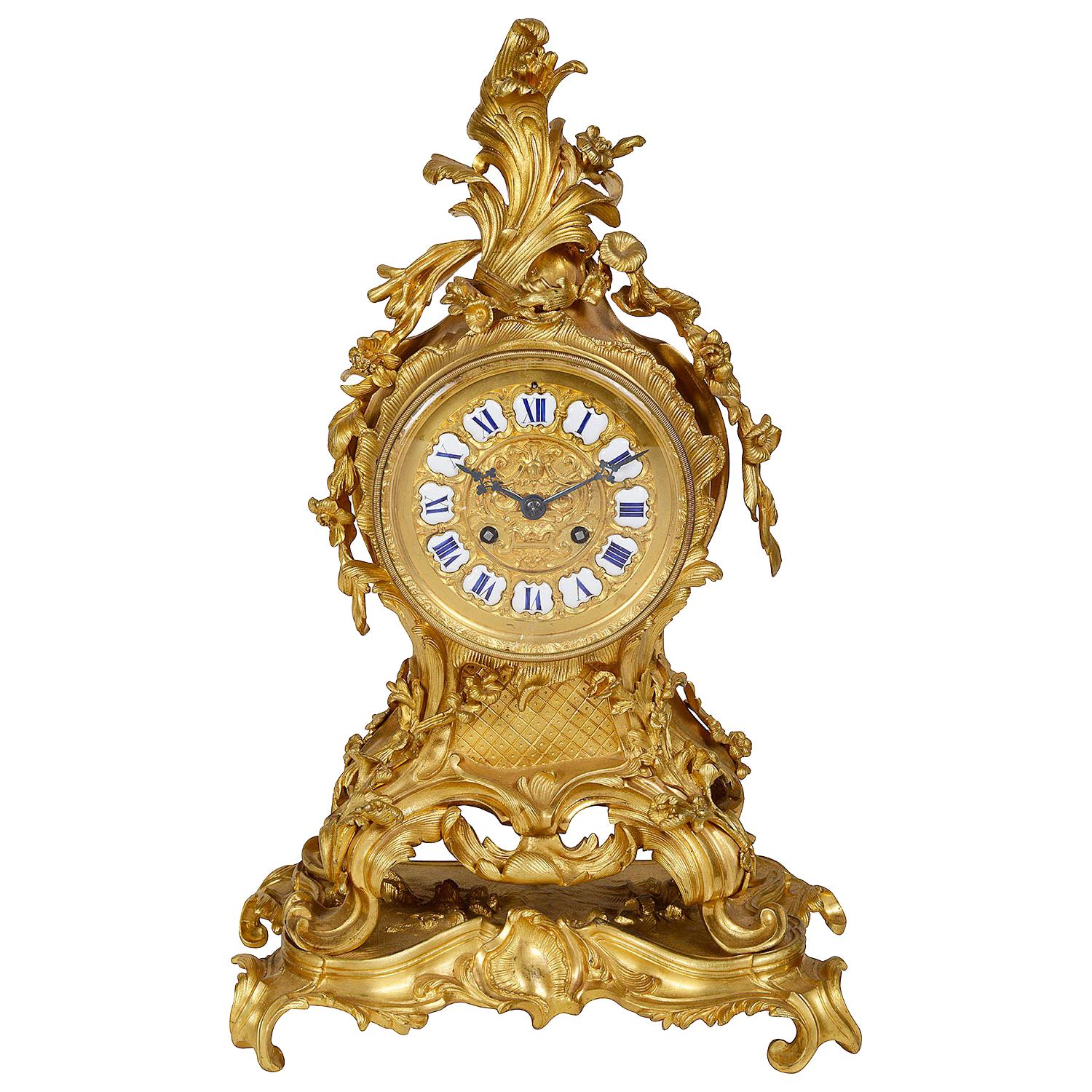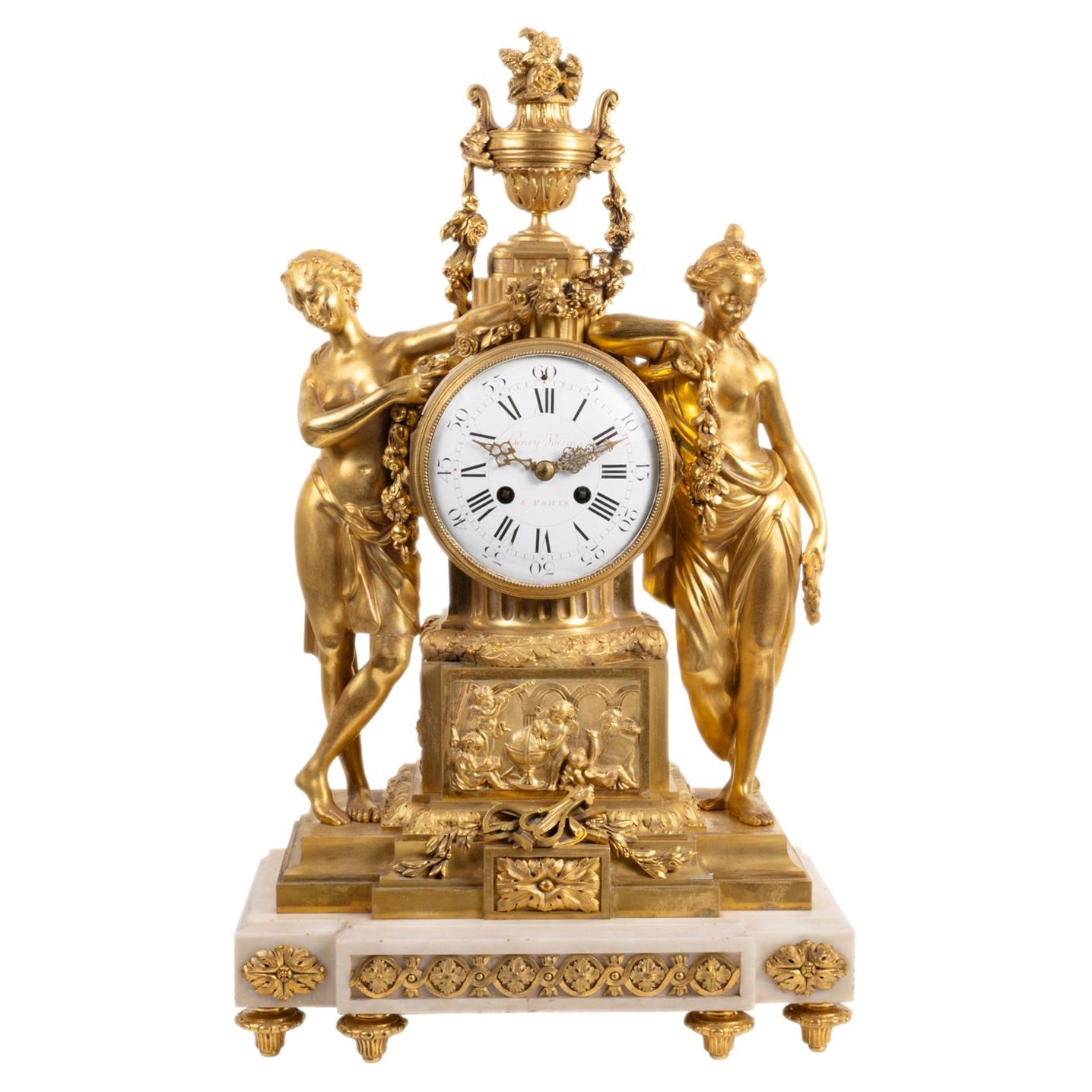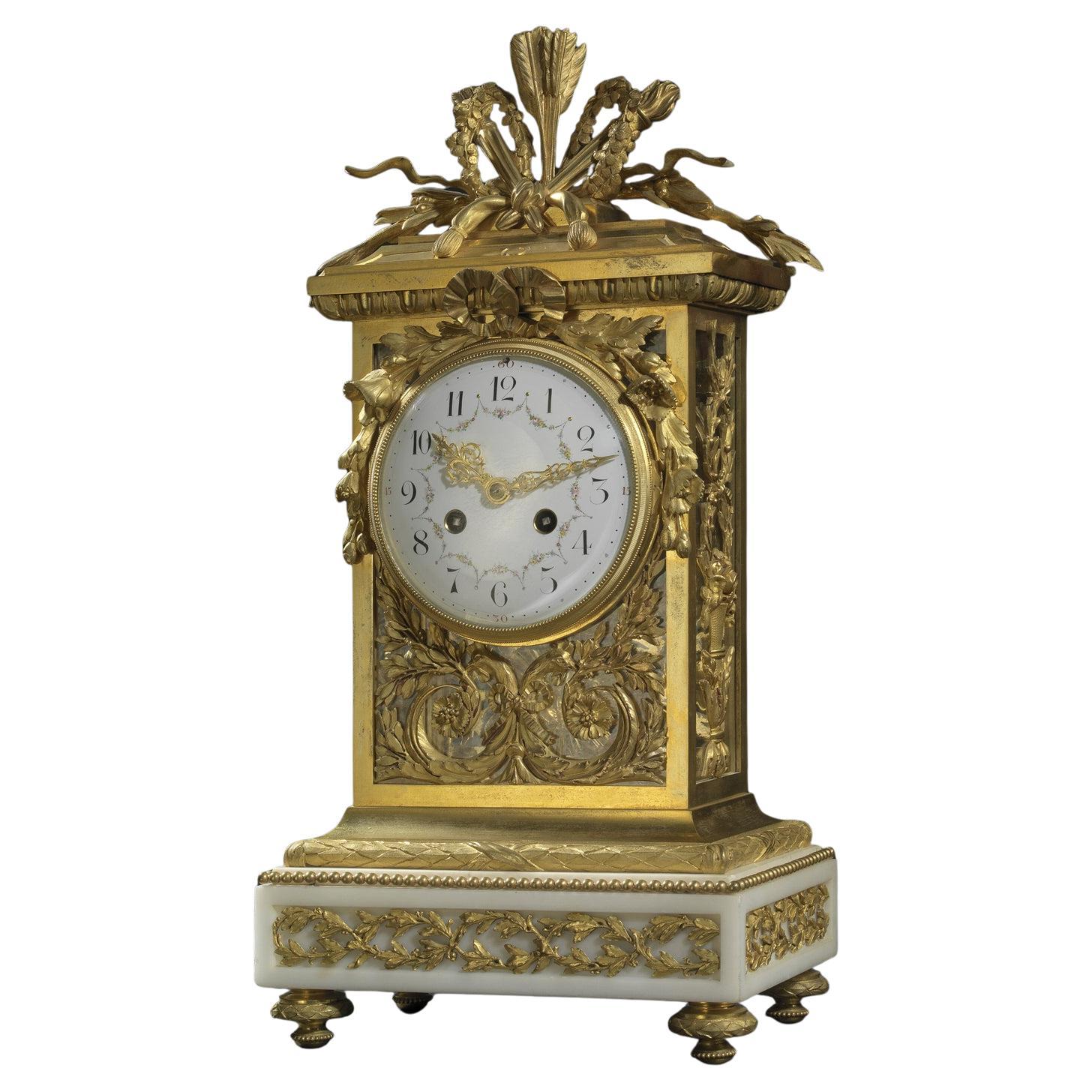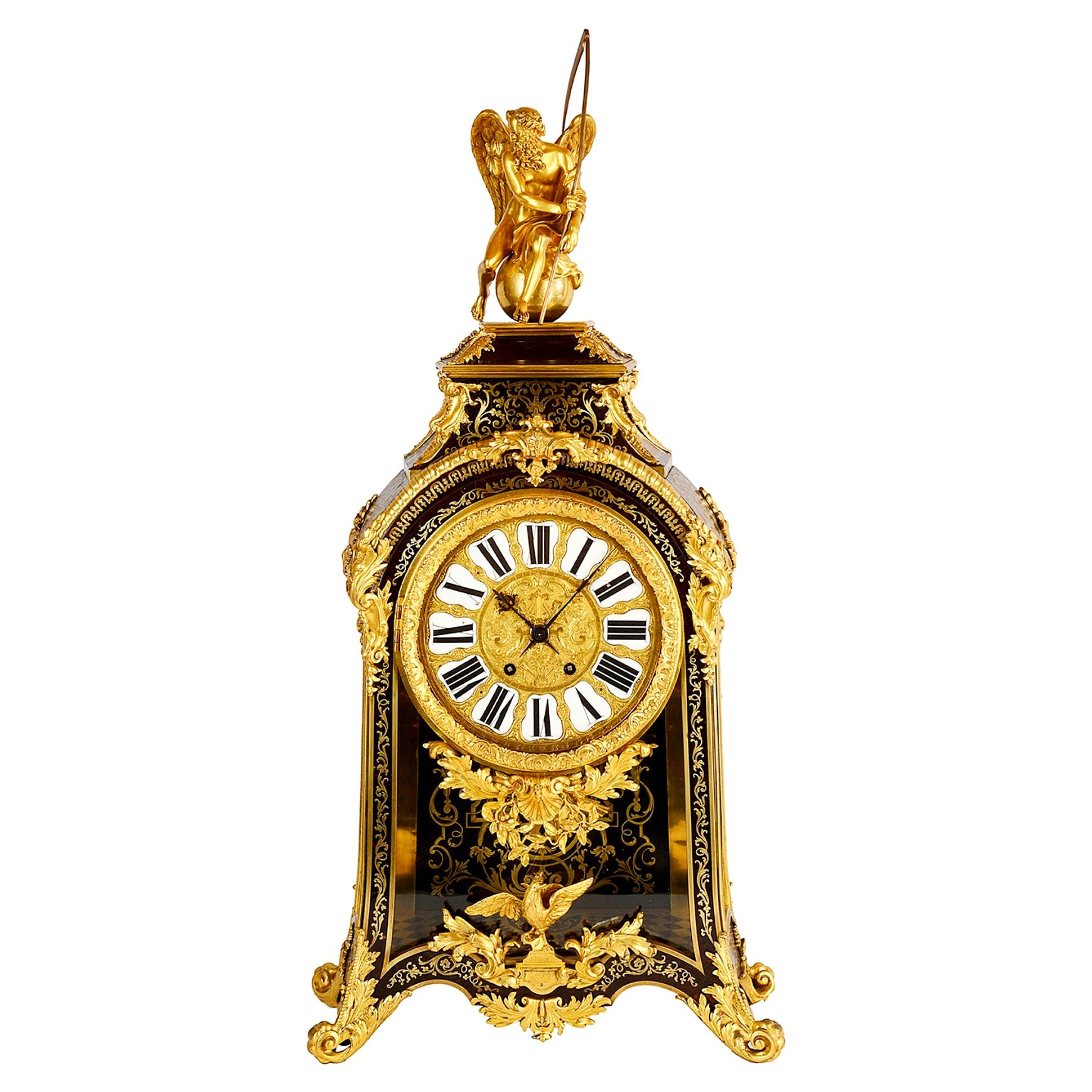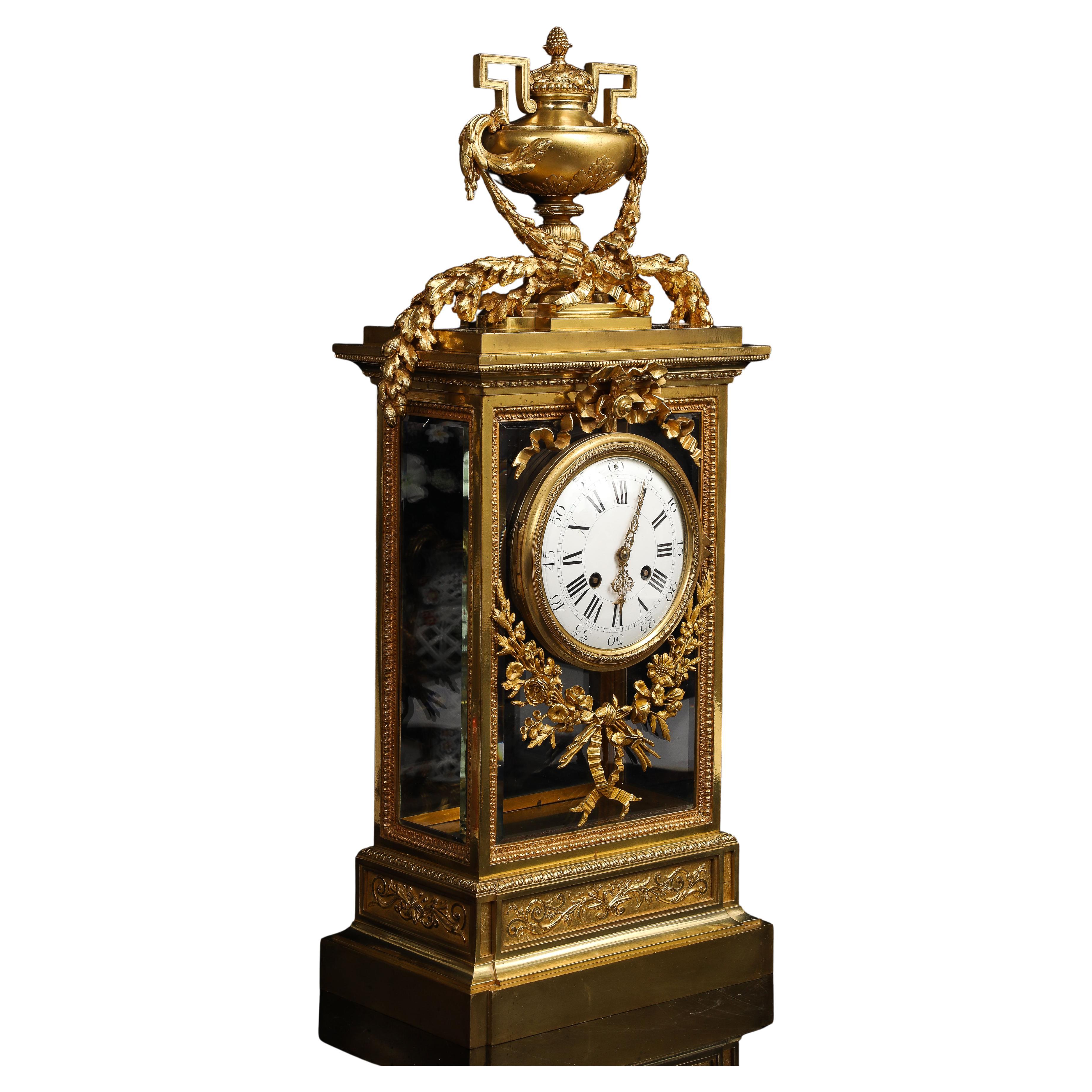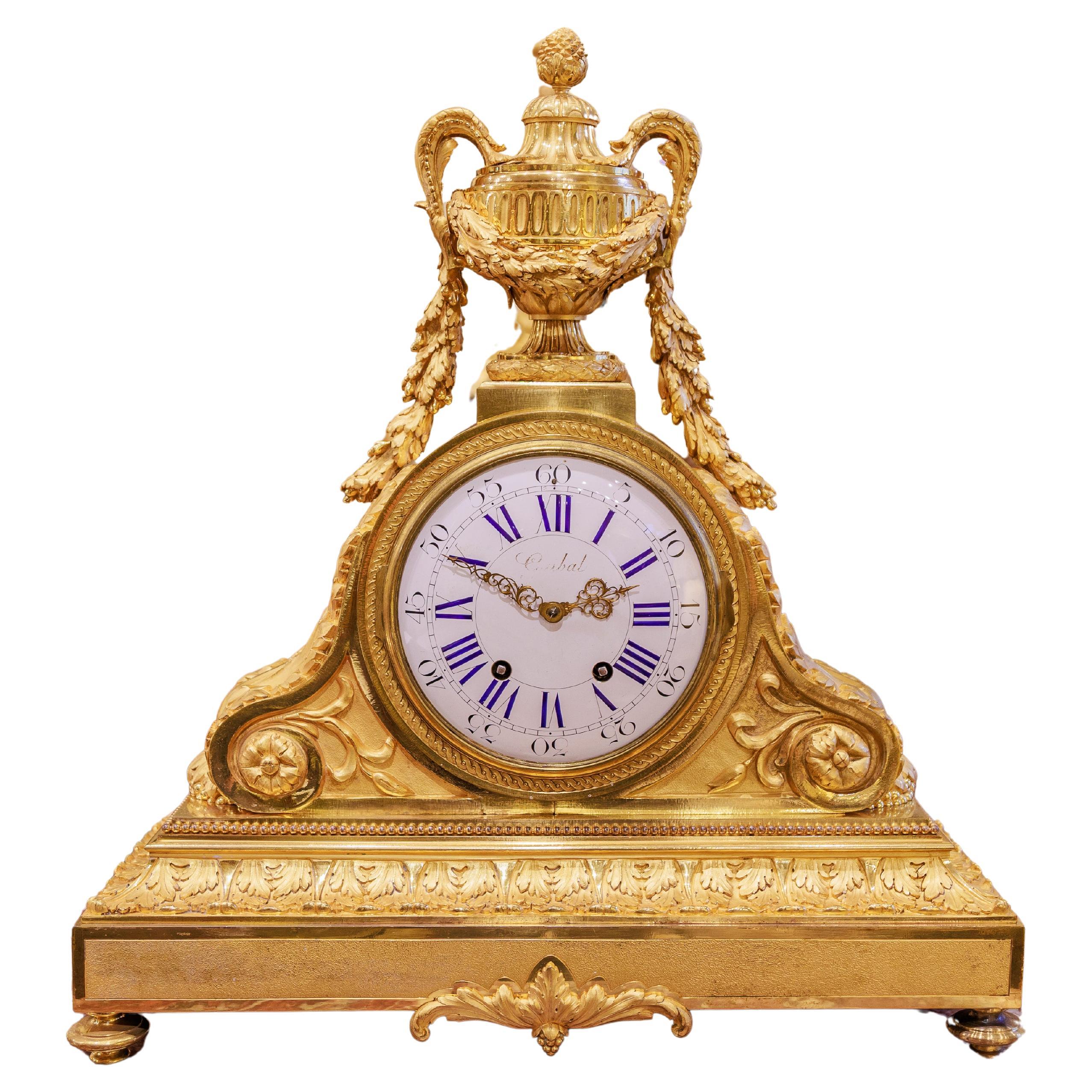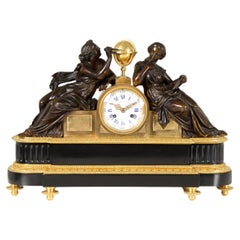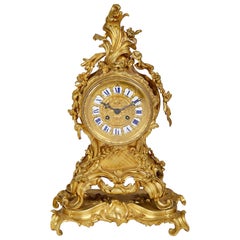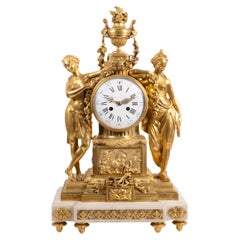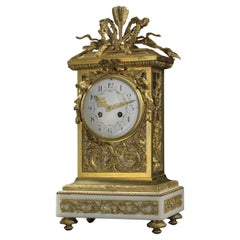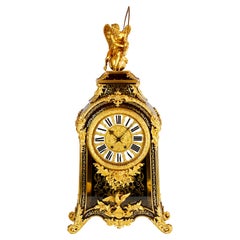Items Similar to 19th Century Parisian Mantel Clock in Louis XVI Style, signed Lepine, circa 1870
Video Loading
Want more images or videos?
Request additional images or videos from the seller
1 of 16
19th Century Parisian Mantel Clock in Louis XVI Style, signed Lepine, circa 1870
$5,818.62
£4,426.67
€4,900
CA$8,162.66
A$8,906.95
CHF 4,608.17
MX$106,553.84
NOK 58,212.22
SEK 54,660.36
DKK 37,326.17
About the Item
Mantel Clock in Louis XVI style
Paris
Ormolu, glass, marble
around 1870
Dimensions: H x W x D: 46 x 24 x 17 cm
Description:
Extremely high quality and finely crafted Parisian pendule in the Louis XVI style from the second half of the 19th century.
Standing on round, downwardly tapering feet, the Carrara marble base is decorated with inlaid laurel tendrils and inlaid beadwork.
A much narrower stele with bronze openwork in front of glazed surfaces rises on top. The blue of the original glass panes contrasts beautifully with the fire-gilt bronze and emphasises the warm hue of the ormolu.
Below the dial we see two roosters rising from acanthus tendrils, the symbols and heraldic animals of France. The Louis XVI bow that connects the two roosters is also found above the dial.
The sides of the clock are also elaborately crafted. Once again against a blue background, we see full baskets of flowers, rose and laurel branches. The interplay of lustre and matt gilding enlivens the work. Details such as leaf structures and wickerwork are finely worked out and are clearly recognisable in some of the photos.
An arrangement of arrows, torches and rosaries, supported on a cushion and held by a ribbon, forms the crown of the clock. Here, too, the high quality of the bronze work is evident in the finely chiselled details.
The enamelled dial behind domed glass is in fantastic condition. The Roman numerals on the hours echo the blue of the glass, while the minute track, Arabic numerals and signature are in black: Lepine, Place des Victoires, 2, Paris.
The signature, as well as the striking stamp on the back of the movement, stands for Maison Lepine, founded by Jean-Antoine Lépine (1720-1814), clockmaker to the royal court, whose workshop was continued by his son-in-law Raguet from 1792. The Lepine workshop and adjoining shop changed hands several times over the course of the 19th century, the watchmaking was largely outsourced, but the name Lepine, which was widely recognised and synonymous with top quality, was always stamped on the clocks. The business operated under the name Lepine until 1919, when it was finally sold to the Leroy family of clockmakers and henceforth bore this name.
The French pendulum movement with an eight-day power reserve and locking disc striking mechanism was manufactured by S. Marti & Cie for Maison Lepine. A corresponding stamp can also be found on the back plate of the movement.
The exquisitely crafted, fire-gilt sun pendulum suspended from a pendulum spring is worthy of mention. Such an elaborate pendulum is rarely found in clocks in which the pendulum is not visible from the outside. Although the pendulum movement can be recognised through the blue glass, the fineness of the bronze cannot. The fact that the pendulum and movement originally belong together is shown by the identical strike mark on both parts: 26398.
The bronze work is attributed to the Denière Fils workshop, which was based on Rue Charlot in Paris from 1860-1890 (see Tardy Dictionnaire Horlogers Francais p. 176). Several stamped, almost identical bronze pieces by Denière are known. The quality corresponds to the clock offered here. Denière was famous for his exceptional bronze casts and exhibited at the Paris World Exhibition in 1855. He had several royal commissions, including the coronation carriage of Charles X.
Condition:
Flawless and absolutely desirable condition of the case. The condition of the original fire gilding is outstanding and almost free of abrasion.
The movement has been completely dismantled, cleaned and overhauled. The clock runs reliably and accurately.
You can find out more about the Maison Lepine in the following reference book:
Tardy - Dictionnaire des Horlogers Fancais from p. 286
The signature S.Marti is itemised in the following reference book:
Kochmann - Clock & Watch Trademark Index p. 259
- Creator:Lepine (Workshop/Studio),Samuel Marty (Clockmaker)
- Attributed to:Guillaume Denière (Metalworker)
- Dimensions:Height: 18.12 in (46 cm)Width: 9.45 in (24 cm)Depth: 6.7 in (17 cm)
- Style:Louis XVI (In the Style Of)
- Materials and Techniques:
- Place of Origin:
- Period:
- Date of Manufacture:1870
- Condition:Wear consistent with age and use. Flawless and absolutely desirable condition of the case. The condition of the original fire gilding is outstanding and almost free of abrasion. The movement has been completely dismantled, cleaned and overhauled. The clock runs reliably and accuratel.
- Seller Location:Greven, DE
- Reference Number:1stDibs: LU5419241593012
About the Seller
4.9
Platinum Seller
Premium sellers with a 4.7+ rating and 24-hour response times
Established in 2014
1stDibs seller since 2020
207 sales on 1stDibs
Typical response time: 1 hour
- ShippingRetrieving quote...Shipping from: Münster, Germany
- Return Policy
More From This Seller
View AllEarly 19th Century French Mantel Clock, signed Ferey au Havre, Ormolu
Located in Greven, DE
Small mantel clock with bas-relief
France
Bronze, enamel
early 19th century
Dimensions: H x W x D: 33 x 19 x 9 cm
Description:
Antique, fire-gilt portal clock with figurative, Gre...
Category
Antique Early 19th Century French Empire Mantel Clocks
Materials
Bronze, Enamel, Ormolu
Early 19th Century French Empire Mantel Clock, Portal Pendule, Paris circa 1820
By Duval
Located in Greven, DE
Antique French round arch portal clock
France (Paris)
Bronze, enamel
Empire circa 1820
Dimensions: H x W x D: 47 x 26 x 12 cm
Description:
Very beautiful, strictly architecturally...
Category
Antique Early 19th Century French Empire Mantel Clocks
Materials
Bronze, Enamel
19th Century French Louis XVI Style "Astronomy" Mantel Clock, circa 1845
By Perrelet
Located in Greven, DE
French mantel clock "Astronomy"
Paris
Bronze, marble
Mid 19th century
Dimensions: H x W x D: 38 x 55 x 16 cm
Description:
A Louis XVI-style figural mantel clock mounted on a two-t...
Category
Antique 1840s French Louis XVI Mantel Clocks
Materials
Marble, Bronze
French Empire Ormulu Bronze Mantel Clock, Lepaute, Thomire, Paris, circa 1815
Located in Greven, DE
Ormulu pendule with depiction of friendship and love
Paris (Lepaute, Thomire)
fire-gilt bronze
Empire around 1815
Dimensions: H x W x D: 44 x 36 x 13 cm
French pendulum movement with eight days duration. Thread suspension and lock disc striking movement with strike on bell on the half and full hour.
White enamel dial with Roman hour numerals and Breguet hands.
Signature: LePaute & Fils / Hrl. du Roi (Pierre-Basile Lepaute (1750 - 1843) with his son Pierre-Michel Lepaute (1785-1849); from 1811 in joint workshop).
Description:
The extremely high quality pendulum shown here takes up a profound theme: Friendship, which combines with love and can thereby outlast time and death. As it is typical for the epoch of classicism, personifications and symbols are taken from the fund of ancient mythology and art and then developed further.
The main figure is a young woman in an antique, girded garment, standing barefoot and with crossed legs next to an altar, on which she is leaning with her left elbow. She gracefully bows her head towards a tempestuously approaching Cupid, grasps his right hand with her left and draws him to her bosom, the seat of the heart. The delicate ambivalence of flying towards and being held culminates in the trustingly intimate look that the two cast at each other.
The young woman personifies friendship, the winged Cupid love. As a sign of their intimate connection, two burning hearts appear on the altar next to the two, framed by the puffed scarf, which are closely bound together by a chain of flowers.
Next to them, on the altar slab, one can see an erected book with the title "Amitie" (French: amitie, friendship). Supporting the book is a pomegranate held by a ring of pomegranate flowers. The bursting seeds spill out of the cracked skin. Since ancient times, the pomegranate and its blossoms have been dedicated to the goddess Persephone, symbolizing the underworld and death, but also life and fertility. The myrtle interwoven in the pomegranate flower wreath of "friendship" also has a far-reaching symbolic power: the plant was dedicated to the goddess Aphrodite, stands for virginity, and was and is therefore obligatory in the bridal wreath...
Category
Antique Early 19th Century French Empire Mantel Clocks
Materials
Bronze, Enamel
19th French Empire Mantel Clock, Pendule, Mercury, Gilded Bronze, circa 1815
Located in Greven, DE
19th century French pendule, mantel clock - Mercury the messenger of the gods
France
Bronze gilded
Empire around 1815
Dimensions: H x W x D: 37 x 30 x 10 cm
Description:
French Empire...
Category
Antique Early 19th Century French Empire Mantel Clocks
Materials
Bronze
19th Century Mantel Clock "Astronomy", France circa 1830
Located in Greven, DE
Antique mantel clock on the theme of astronomy
France
Bronze
Charles X around 1830
Dimensions: H x W x D: 48 x 19 x 10 cm
Description:
Unusual and beautifully crafted bronze mante...
Category
Antique 19th Century French Charles X Table Clocks and Desk Clocks
Materials
Bronze
You May Also Like
French 19th Century Rococo Mantel Clock
Located in Brighton, Sussex
A very good quality 19th century French gilded ormolu Louis XVI style mantel clock, having wonderful scrolling foliate decoration in the Rococo style, garlands of flowers draped eith...
Category
Antique Late 19th Century French Louis XVI Mantel Clocks
Materials
Ormolu
Large Louis XVI Style Ormolu Mantel Clock, 19th Century
By Henri Voisin
Located in Brighton, Sussex
A Fine quality French 19th century gilded ormolu and white marble mantel clock in the Louis XVI style. Having a two handled urn to the top with flowers and garlands draping down to t...
Category
Antique Early 19th Century French Louis XVI Mantel Clocks
Materials
Marble, Ormolu
$9,117 Sale Price
20% Off
A Louis XVI Style Mantel Fine Gilt-Bronze Clock by François Linke
By François Linke
Located in Brighton, West Sussex
A Very Fine Gilt-Bronze Clock With A White Marble Base by François Linke.
The case signed 'Linke'.
This rare example of a clock by François Linke has a twin train eight-day mov...
Category
Antique 19th Century French Louis XVI Mantel Clocks
Materials
Marble, Enamel, Ormolu
19th Century French Boulle Mantel Clock
By André-Charles Boulle
Located in Brighton, Sussex
A very impressive 19th century French Boulle inlaid mantel clock. Having a gilded ormolu figure of father time to the top, beautiful brass inlaid decoration to the sides and front. T...
Category
Antique 19th Century French Louis XVI Mantel Clocks
Materials
Brass
Monumental 19th C. French Louis XIV Style Gilt Bronze & Cut Glass Mantel Clock
Located in New York, NY
This monumental 19th-century French mantel clock, crafted in the lavish Louis XIV style, is a commanding expression of regal elegance and technical refinement. Towering in presence, ...
Category
Antique 1870s French Louis XVI Mantel Clocks
Materials
Bronze
$26,120 Sale Price
20% Off
A very fine 19th century French gilt bronze clock
Located in Dallas, TX
A very fine 19th century French Louis XVI gilt bronze mantle clock . Signed by the clockmaker
Category
Antique Late 19th Century French Louis XVI Mantel Clocks
Materials
Bronze
More Ways To Browse
Antique Rosaries
Crown Clock
Deniere Bronze
Royal Carriage
Royal Coronation
Pendule Louis Xvi
French Mahogany Clock
Gold Rococo Clock
Mahogany Bracket Clock
Sevre Panels
Victorian Brass And Marble
Clock Finials
Clock Parts
Red Antique Clock
18th Century Clock Marble
Napoleon Marble Clock
Putti Clock
Antique Tiffany Clocks
